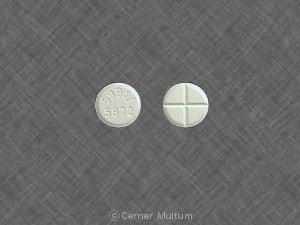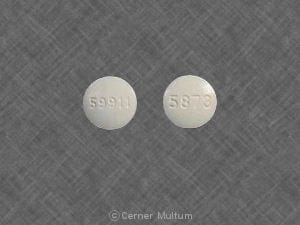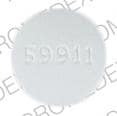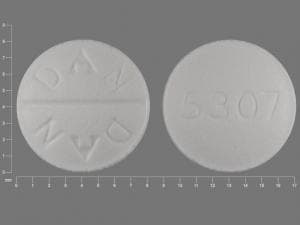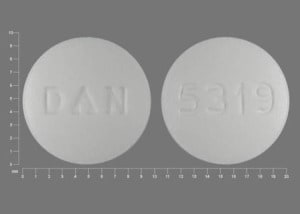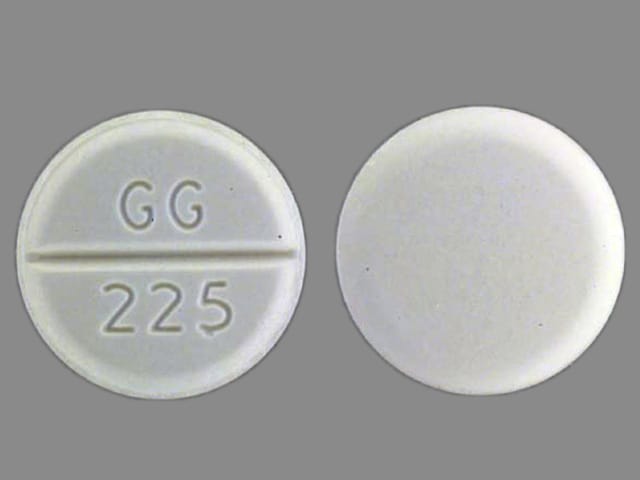Boxed Warning
Respiratory depression - Pediatrics:
Promethazine should not be used in pediatric patients younger than 2 years because of the potential for fatal respiratory depression.
Postmarketing cases of respiratory depression, including fatalities, have been reported with the use of promethazine in pediatric patients younger than 2 years. A wide range of weight-based doses of promethazine have resulted in respiratory depression in these patients.
Exercise caution when administering promethazine to pediatric patients 2 years and older. It is recommended that the lowest effective dose of promethazine be used in pediatric patients 2 years and older and that coadministration with other drugs with respiratory-depressant effects be avoided.
Severe tissue injury, including gangrene (injection):
Promethazine can cause severe chemical irritation and damage to tissues regardless of the route of administration. Irritation and damage can result from perivascular extravasation, unintentional intra-arterial injection, and intraneuronal or perineuronal infiltration. Adverse reactions include burning, pain, thrombophlebitis, tissue necrosis, and gangrene. In some cases, surgical intervention, including fasciotomy, skin graft, and/or amputation have been required.
Due to the risks of intravenous (IV) injection, the preferred route of administration of promethazine is deep intramuscular (IM) injection. Subcutaneous injection is contraindicated.
Dosage Forms
Excipient information presented when available (limited, particularly for generics); consult specific product labeling. [DSC] = Discontinued product
Solution, Injection, as hydrochloride:
Phenergan: 50 mg/mL (1 mL) [contains edetate disodium, phenol, sodium metabisulfite]
Phenergan: 25 mg/mL (1 mL) [pyrogen free; contains edetate disodium, phenol, sodium metabisulfite]
Generic: 25 mg/mL (1 mL); 50 mg/mL (1 mL)
Solution, Oral, as hydrochloride:
Generic: 6.25 mg/5 mL (118 mL [DSC], 473 mL)
Suppository, Rectal, as hydrochloride:
Phenadoz: 12.5 mg (12 ea); 25 mg (12 ea)
Phenergan: 12.5 mg (12 ea [DSC]); 25 mg (12 ea [DSC]); 50 mg (12 ea [DSC])
Promethegan: 12.5 mg (1 ea, 12 ea); 25 mg (12 ea, 1000 ea [DSC]); 50 mg (1 ea, 12 ea)
Generic: 12.5 mg (1 ea, 12 ea); 25 mg (1 ea, 12 ea); 50 mg (12 ea [DSC])
Syrup, Oral, as hydrochloride:
Generic: 6.25 mg/5 mL (118 mL [DSC], 473 mL)
Tablet, Oral, as hydrochloride:
Generic: 12.5 mg, 25 mg, 50 mg
Pharmacology
Mechanism of Action
Phenothiazine derivative; blocks postsynaptic mesolimbic dopaminergic receptors in the brain; exhibits a strong alpha-adrenergic blocking effect and depresses the release of hypothalamic and hypophyseal hormones; competes with histamine for the H1-receptor; muscarinic-blocking effect may be responsible for antiemetic activity; reduces stimuli to the brainstem reticular system
Pharmacokinetics/Pharmacodynamics
Absorption
Oral: Rapid and complete; large first pass effect limits systemic bioavailability (Sharma, 2003)
Distribution
Vd: 13.4 ± 3.6 L/kg (Brunton 2011)
Metabolism
Hepatic; hydroxylation via CYP2D6 and N-demethylation via CYP2B6; significant first-pass effect (Sharma, 2003)
Excretion
Urine, feces as inactive metabolites
Onset of Action
Oral, IM: ~20 minutes; IV: ~5 minutes
Time to Peak
Maximum serum concentration (Brunton 2011): Oral (syrup): 2.8 ± 1.4 hours; Rectal: 8.2 ± 3.4 hours
Duration of Action
Usually 4 to 6 hours (up to 12 hours)
Half-Life Elimination
IM: ~10 hours; IV: 9 to 16 hours; Suppositories, syrup: 16 to 19 hours (range: 4 to 34 hours) (Strenkoski-Nix 2000)
Protein Binding
93% (Brunton 2011)
Use: Labeled Indications
Allergic conditions, treatment: Perennial and seasonal allergic rhinitis; vasomotor rhinitis; allergic conjunctivitis due to inhalant allergens and foods; mild, uncomplicated allergic skin manifestations of urticaria and angioedema; amelioration of allergic reactions to blood or plasma; dermographism; anaphylactic reactions, as adjunctive therapy to epinephrine and other standard measures, after the acute manifestations have been controlled
Nausea and vomiting: Prevention and control of nausea and vomiting associated with certain types of anesthesia and surgery; antiemetic therapy in postoperative patients
Motion sickness: Active and prophylactic treatment of motion sickness
Surgical analgesia/hypnotic; pre-/postoperative adjunct: Adjunctive therapy with analgesics and/or anesthesia
Sedation: Preoperative, postoperative, and obstetric sedation; for sedation, relief of apprehension, and production of light sleep from which the patient can be easily aroused
Use: Off Label
Nausea and vomiting of pregnancycyes
Data from a limited number of patients studied suggest that promethazine may be beneficial for the treatment of nausea and vomiting of pregnancy (NVP) Fitzgerald 1955, Tan 2010.
Based on the American Society of Obstetricians and Gynecologists (ACOG) and the Society of Obstetricians and Gynaecologists of Canada (SOGC) practice guidelines, promethazine is effective for the treatment of NVP as adjunctive therapy when the preferred agents do not provide symptom improvement ACOG 189 2018, SOGC [Campbell 2016]. Promethazine is recommended as a first-line therapy by The Royal College of Obstetricians & Gynaecologists RCOG 2016.
Contraindications
Hypersensitivity or idiosyncratic reaction to promethazine, other phenothiazines, or any component of the formulation; coma; treatment of lower respiratory tract symptoms, including asthma; children <2 years of age; intra-arterial or subcutaneous administration
Dosage and Administration
Dosing: Adult
Note: ISMP discourages the use of injectable promethazine (any route) because of the risk of severe tissue damage (ISMP 2018).
Allergic conditions, treatment:
Oral, rectal: 25 mg at bedtime or 12.5 mg before meals and at bedtime (usual range: 6.25 to 12.5 mg 3 times daily)
IM, IV: 25 mg, may repeat in 2 hours when necessary; switch to oral route as soon as feasible
Motion sickness: Oral, rectal: Initial: 25 mg 30 to 60 minutes before departure; repeat 8 to 12 hours later as needed; maintenance: 25 mg twice daily.
Nausea and vomiting: Oral, IM, IV, rectal: 12.5 to 25 mg every 4 to 6 hours, as needed
Nausea and vomiting of pregnancy (off-label use): Oral, IM, IV, rectal: 12.5 to 25 mg every 4 to 6 hours, as needed (ACOG 189 2018)
Obstetrics (labor), adjunct to analgesia: IM, IV: Early labor: 50 mg; Established labor: 25 to 75 mg in combination with analgesic at reduced dosage; may repeat every 4 hours for up to 2 additional doses (maximum: 100 mg/day while in labor)
Surgical analgesia/hypnotic; pre-/postoperative adjunct: IM, IV: 25 to 50 mg in combination with analgesic or hypnotic (at reduced dosage)
Sedation: Oral, IM, IV, rectal: 25 to 50 mg/dose
Dosing: Geriatric
Avoid use (Beers Criteria [AGS 2019]).
Dosing: Pediatric
Note: Use with extreme caution utilizing the lowest most effective dose: Use has generally been replaced by agents that are more effective with fewer adverse events.
Allergic conditions; treatment: Children ≥2 years and Adolescents: Limited data available: Oral: 0.125 mg/kg/dose (maximum dose: 12.5 mg/dose) every 6 hours as needed during the day and 0.5 mg/kg/dose (maximum dose: 25 mg/dose) at bedtime as needed. Note: Not typically a first-line option for allergic conditions; other agents may be more effective with fewer adverse effects.
Nausea and vomiting: Children ≥2 years and Adolescents: Oral, IM, IV, rectal: 0.25 to 1 mg/kg/dose every 4 to 6 hours as needed (Kliegman 2007); maximum dose: 25 mg/dose. Note: Expert recommendations for postoperative nausea and vomiting (PONV) management do not include promethazine as an option for the prevention or treatment of PONV in pediatric patients; use replaced by newer agents (SAA [Gan 2014]; WHO 2011).
Motion sickness: Children ≥2 years and Adolescents: Oral, rectal: 0.5 mg/kg 30 minutes to 1 hour before departure, then every 12 hours as needed (Kliegman 2007); maximum dose: 25 mg/dose
Surgical analgesia/hypnotic; pre-/postoperative adjunct: Children ≥2 years and Adolescents: IM, IV: 0.25 to 1.1 mg/kg once in combination with an analgesic or hypnotic (at reduced dosage; low end of range) and with an atropine-like agent (at appropriate dosage) (Kliegman 2007). Promethazine dosage should not exceed 12.5 to 25 mg (ie, half of suggested adult dosage).
Reconstitution
Parenteral: IV: Administration through IV route should be avoided. In rare cases when deemed necessary, the following extra precautionary steps should be considered: Further dilute the 25 mg/mL preparation in 10 to 20 mL of NS (Reynolds 2014).
Administration
Oral: Administer with food, water, or milk to decrease GI distress. Measure and administer prescribed dose of oral solution using dosing syringe, dosing spoon, or dosing cup.
Parenteral: Not for SubQ administration; promethazine is a chemical irritant which may produce necrosis. Note: ISMP discourages the use of injectable promethazine (any route) because of the risk of severe tissue damage (ISMP 2018).
IM: Preferred route of parenteral administration; administer as a deep IM injection
IV: IV use should be avoided when possible since severe tissue damage has occurred with IV administration; in selected patients, promethazine has been diluted and infused at a maximum rate of 25 mg/minute. To minimize phlebitis, consider administering over 10 to 15 minutes, limiting initial dose to 1/4 or 1/2 the usual dose (eg, in adults 6.25 to 12.5 mg), further diluting the 25 mg/mL strength in 10 to 20 mL NS, and administering through a large bore vein (not hand or wrist) or via a running IV line at port farthest from patient's vein (Reynolds 2014).
Vesicant; ensure proper needle or catheter placement prior to and during infusion; avoid extravasation. Discontinue immediately if burning or pain occurs with administration; evaluate for inadvertent arterial injection or extravasation.
Extravasation management: If extravasation occurs, stop infusion immediately and disconnect (leave cannula/needle in place); gently aspirate extravasated solution (do NOT flush the line); remove needle/cannula; elevate extremity. Information conflicts regarding the use of dry warm or dry cold compresses (Hurst 2004; Reynolds 2014).
Dietary Considerations
Increase dietary intake of riboflavin.
Storage
Injection, oral solution, tablets: Store between 20°C and 25°C (68°F and 77°F). Protect from light.
Suppositories: Store refrigerated between 2°C and 8°C (36°F and 46°F).
Promethazine Images
Drug Interactions
Acetylcholinesterase Inhibitors: May diminish the therapeutic effect of Anticholinergic Agents. Anticholinergic Agents may diminish the therapeutic effect of Acetylcholinesterase Inhibitors. Monitor therapy
Aclidinium: May enhance the anticholinergic effect of Anticholinergic Agents. Avoid combination
Alcohol (Ethyl): CNS Depressants may enhance the CNS depressant effect of Alcohol (Ethyl). Monitor therapy
Alizapride: May enhance the CNS depressant effect of CNS Depressants. Monitor therapy
Amantadine: May enhance the anticholinergic effect of Anticholinergic Agents. Monitor therapy
Aminolevulinic Acid (Systemic): Photosensitizing Agents may enhance the photosensitizing effect of Aminolevulinic Acid (Systemic). Avoid combination
Aminolevulinic Acid (Topical): Photosensitizing Agents may enhance the photosensitizing effect of Aminolevulinic Acid (Topical). Monitor therapy
Anticholinergic Agents: May enhance the adverse/toxic effect of other Anticholinergic Agents. Monitor therapy
Azelastine (Nasal): CNS Depressants may enhance the CNS depressant effect of Azelastine (Nasal). Avoid combination
Blonanserin: CNS Depressants may enhance the CNS depressant effect of Blonanserin. Consider therapy modification
Botulinum Toxin-Containing Products: May enhance the anticholinergic effect of Anticholinergic Agents. Monitor therapy
Brexanolone: CNS Depressants may enhance the CNS depressant effect of Brexanolone. Monitor therapy
Brimonidine (Topical): May enhance the CNS depressant effect of CNS Depressants. Monitor therapy
Bromopride: May enhance the adverse/toxic effect of Promethazine. Avoid combination
Bromperidol: May enhance the CNS depressant effect of CNS Depressants. Avoid combination
Buprenorphine: CNS Depressants may enhance the CNS depressant effect of Buprenorphine. Management: Consider reduced doses of other CNS depressants, and avoiding such drugs in patients at high risk of buprenorphine overuse/self-injection. Initiate buprenorphine at lower doses in patients already receiving CNS depressants. Consider therapy modification
Cannabidiol: May enhance the CNS depressant effect of CNS Depressants. Monitor therapy
Cannabis: May enhance the CNS depressant effect of CNS Depressants. Monitor therapy
Chloral Betaine: May enhance the adverse/toxic effect of Anticholinergic Agents. Monitor therapy
Chlormethiazole: May enhance the CNS depressant effect of CNS Depressants. Management: Monitor closely for evidence of excessive CNS depression. The chlormethiazole labeling states that an appropriately reduced dose should be used if such a combination must be used. Consider therapy modification
Chlorphenesin Carbamate: May enhance the adverse/toxic effect of CNS Depressants. Monitor therapy
Cimetropium: Anticholinergic Agents may enhance the anticholinergic effect of Cimetropium. Avoid combination
CNS Depressants: May enhance the adverse/toxic effect of other CNS Depressants. Monitor therapy
Dimethindene (Topical): May enhance the CNS depressant effect of CNS Depressants. Monitor therapy
Doxylamine: May enhance the CNS depressant effect of CNS Depressants. Management: The manufacturer of Diclegis (doxylamine/pyridoxine), intended for use in pregnancy, specifically states that use with other CNS depressants is not recommended. Monitor therapy
Dronabinol: May enhance the CNS depressant effect of CNS Depressants. Monitor therapy
Droperidol: May enhance the CNS depressant effect of CNS Depressants. Management: Consider dose reductions of droperidol or of other CNS agents (eg, opioids, barbiturates) with concomitant use. Exceptions to this monograph are discussed in further detail in separate drug interaction monographs. Consider therapy modification
Eluxadoline: Anticholinergic Agents may enhance the constipating effect of Eluxadoline. Avoid combination
EPINEPHrine (Nasal): Promethazine may diminish the vasoconstricting effect of EPINEPHrine (Nasal). Monitor therapy
EPINEPHrine (Oral Inhalation): Promethazine may diminish the therapeutic effect of EPINEPHrine (Oral Inhalation). Monitor therapy
Epinephrine (Racemic): Promethazine may diminish the vasoconstricting effect of Epinephrine (Racemic). Management: Monitor for diminished vasoconstrictive effects of racemic epinephrine (e.g., diminished efficacy when used for gingival retraction). This interaction is likely of less concern in patients receiving epinephrine for other purposes (e.g., bronchodilation). Monitor therapy
EPINEPHrine (Systemic): Promethazine may diminish the vasoconstricting effect of EPINEPHrine (Systemic). Management: When vasoconstrictive effects are desired in patients receiving promethazine, consider alternatives to epinephrine. Consider use of norepinephrine or phenylephrine, and avoid epinephrine, when treating hypotension associated with promethazine overdose. Consider therapy modification
Esketamine: May enhance the CNS depressant effect of CNS Depressants. Monitor therapy
Flunitrazepam: CNS Depressants may enhance the CNS depressant effect of Flunitrazepam. Consider therapy modification
Gastrointestinal Agents (Prokinetic): Anticholinergic Agents may diminish the therapeutic effect of Gastrointestinal Agents (Prokinetic). Monitor therapy
Glucagon: Anticholinergic Agents may enhance the adverse/toxic effect of Glucagon. Specifically, the risk of gastrointestinal adverse effects may be increased. Monitor therapy
Glycopyrrolate (Oral Inhalation): Anticholinergic Agents may enhance the anticholinergic effect of Glycopyrrolate (Oral Inhalation). Avoid combination
Glycopyrronium (Topical): May enhance the anticholinergic effect of Anticholinergic Agents. Avoid combination
Haloperidol: Promethazine may enhance the anticholinergic effect of Haloperidol. Promethazine may enhance the CNS depressant effect of Haloperidol. Promethazine may increase the serum concentration of Haloperidol. Monitor therapy
HYDROcodone: CNS Depressants may enhance the CNS depressant effect of HYDROcodone. Management: Avoid concomitant use of hydrocodone and benzodiazepines or other CNS depressants when possible. These agents should only be combined if alternative treatment options are inadequate. If combined, limit the dosages and duration of each drug. Consider therapy modification
HydrOXYzine: May enhance the CNS depressant effect of CNS Depressants. Monitor therapy
Ipratropium (Oral Inhalation): May enhance the anticholinergic effect of Anticholinergic Agents. Avoid combination
Itopride: Anticholinergic Agents may diminish the therapeutic effect of Itopride. Monitor therapy
Kava Kava: May enhance the adverse/toxic effect of CNS Depressants. Monitor therapy
Lemborexant: May enhance the CNS depressant effect of CNS Depressants. Management: Dosage adjustments of lemborexant and of concomitant CNS depressants may be necessary when administered together because of potentially additive CNS depressant effects. Close monitoring for CNS depressant effects is necessary. Consider therapy modification
Levosulpiride: Anticholinergic Agents may diminish the therapeutic effect of Levosulpiride. Avoid combination
Lofexidine: May enhance the CNS depressant effect of CNS Depressants. Management: Drugs listed as exceptions to this monograph are discussed in further detail in separate drug interaction monographs. Monitor therapy
Magnesium Sulfate: May enhance the CNS depressant effect of CNS Depressants. Monitor therapy
Methotrimeprazine: CNS Depressants may enhance the CNS depressant effect of Methotrimeprazine. Methotrimeprazine may enhance the CNS depressant effect of CNS Depressants. Management: Reduce adult dose of CNS depressant agents by 50% with initiation of concomitant methotrimeprazine therapy. Further CNS depressant dosage adjustments should be initiated only after clinically effective methotrimeprazine dose is established. Consider therapy modification
Metoclopramide: May enhance the adverse/toxic effect of Promethazine. Avoid combination
MetyroSINE: May enhance the adverse/toxic effect of Promethazine. Monitor therapy
Mianserin: May enhance the anticholinergic effect of Anticholinergic Agents. Monitor therapy
Minocycline (Systemic): May enhance the CNS depressant effect of CNS Depressants. Monitor therapy
Mirabegron: Anticholinergic Agents may enhance the adverse/toxic effect of Mirabegron. Monitor therapy
Nabilone: May enhance the CNS depressant effect of CNS Depressants. Monitor therapy
Nitroglycerin: Anticholinergic Agents may decrease the absorption of Nitroglycerin. Specifically, anticholinergic agents may decrease the dissolution of sublingual nitroglycerin tablets, possibly impairing or slowing nitroglycerin absorption. Monitor therapy
Opioid Agonists: CNS Depressants may enhance the CNS depressant effect of Opioid Agonists. Management: Avoid concomitant use of opioid agonists and benzodiazepines or other CNS depressants when possible. These agents should only be combined if alternative treatment options are inadequate. If combined, limit the dosages and duration of each drug. Consider therapy modification
Orphenadrine: CNS Depressants may enhance the CNS depressant effect of Orphenadrine. Avoid combination
Oxatomide: May enhance the anticholinergic effect of Anticholinergic Agents. Avoid combination
Oxomemazine: May enhance the CNS depressant effect of CNS Depressants. Avoid combination
OxyCODONE: CNS Depressants may enhance the CNS depressant effect of OxyCODONE. Management: Avoid concomitant use of oxycodone and benzodiazepines or other CNS depressants when possible. These agents should only be combined if alternative treatment options are inadequate. If combined, limit the dosages and duration of each drug. Consider therapy modification
Paraldehyde: CNS Depressants may enhance the CNS depressant effect of Paraldehyde. Avoid combination
Perampanel: May enhance the CNS depressant effect of CNS Depressants. Management: Patients taking perampanel with any other drug that has CNS depressant activities should avoid complex and high-risk activities, particularly those such as driving that require alertness and coordination, until they have experience using the combination. Consider therapy modification
Piribedil: CNS Depressants may enhance the CNS depressant effect of Piribedil. Monitor therapy
Porfimer: Photosensitizing Agents may enhance the photosensitizing effect of Porfimer. Monitor therapy
Potassium Chloride: Anticholinergic Agents may enhance the ulcerogenic effect of Potassium Chloride. Management: Patients on drugs with substantial anticholinergic effects should avoid using any solid oral dosage form of potassium chloride. Avoid combination
Potassium Citrate: Anticholinergic Agents may enhance the ulcerogenic effect of Potassium Citrate. Avoid combination
Pramipexole: CNS Depressants may enhance the sedative effect of Pramipexole. Monitor therapy
Pramlintide: May enhance the anticholinergic effect of Anticholinergic Agents. These effects are specific to the GI tract. Consider therapy modification
Ramosetron: Anticholinergic Agents may enhance the constipating effect of Ramosetron. Monitor therapy
Revefenacin: Anticholinergic Agents may enhance the anticholinergic effect of Revefenacin. Avoid combination
ROPINIRole: CNS Depressants may enhance the sedative effect of ROPINIRole. Monitor therapy
Rotigotine: CNS Depressants may enhance the sedative effect of Rotigotine. Monitor therapy
Rufinamide: May enhance the adverse/toxic effect of CNS Depressants. Specifically, sleepiness and dizziness may be enhanced. Monitor therapy
Secretin: Anticholinergic Agents may diminish the therapeutic effect of Secretin. Management: Avoid concomitant use of anticholinergic agents and secretin. Discontinue anticholinergic agents at least 5 half-lives prior to administration of secretin. Consider therapy modification
Selective Serotonin Reuptake Inhibitors: CNS Depressants may enhance the adverse/toxic effect of Selective Serotonin Reuptake Inhibitors. Specifically, the risk of psychomotor impairment may be enhanced. Monitor therapy
Sodium Oxybate: May enhance the CNS depressant effect of CNS Depressants. Management: Consider alternatives to combined use. When combined use is needed, consider minimizing doses of one or more drugs. Use of sodium oxybate with alcohol or sedative hypnotics is contraindicated. Consider therapy modification
Suvorexant: CNS Depressants may enhance the CNS depressant effect of Suvorexant. Management: Dose reduction of suvorexant and/or any other CNS depressant may be necessary. Use of suvorexant with alcohol is not recommended, and the use of suvorexant with any other drug to treat insomnia is not recommended. Consider therapy modification
Tapentadol: May enhance the CNS depressant effect of CNS Depressants. Management: Avoid concomitant use of tapentadol and benzodiazepines or other CNS depressants when possible. These agents should only be combined if alternative treatment options are inadequate. If combined, limit the dosages and duration of each drug. Consider therapy modification
Tetrahydrocannabinol: May enhance the CNS depressant effect of CNS Depressants. Monitor therapy
Tetrahydrocannabinol and Cannabidiol: May enhance the CNS depressant effect of CNS Depressants. Monitor therapy
Thalidomide: CNS Depressants may enhance the CNS depressant effect of Thalidomide. Avoid combination
Thiazide and Thiazide-Like Diuretics: Anticholinergic Agents may increase the serum concentration of Thiazide and Thiazide-Like Diuretics. Monitor therapy
Tiotropium: Anticholinergic Agents may enhance the anticholinergic effect of Tiotropium. Avoid combination
Topiramate: Anticholinergic Agents may enhance the adverse/toxic effect of Topiramate. Monitor therapy
Trimeprazine: May enhance the CNS depressant effect of CNS Depressants. Monitor therapy
Umeclidinium: May enhance the anticholinergic effect of Anticholinergic Agents. Avoid combination
Verteporfin: Photosensitizing Agents may enhance the photosensitizing effect of Verteporfin. Monitor therapy
Zolpidem: CNS Depressants may enhance the CNS depressant effect of Zolpidem. Management: Reduce the Intermezzo brand sublingual zolpidem adult dose to 1.75 mg for men who are also receiving other CNS depressants. No such dose change is recommended for women. Avoid use with other CNS depressants at bedtime; avoid use with alcohol. Consider therapy modification
Test Interactions
Pregnancy tests (hCG-based) may result in false-negatives or false-positives; increased serum glucose may be seen with glucose tolerance tests; may result in false-positives with urine detection of amphetamine/methamphetamine (Melanson 2006); may alter the flare response in intradermal allergen tests (Melanson 2006)
Adverse Reactions
Frequency not defined.
Cardiovascular: Bradycardia, decreased blood pressure, increased blood pressure, local thrombophlebitis (injection), localized phlebitis (injection), peripheral vasospasm (injection), tachycardia, venous thrombosis (injection)
Central nervous system: Abnormal sensory symptoms (injection), agitation, catatonia, confusion, delirium, disorientation, dizziness, drowsiness, euphoria, excitement, extrapyramidal reaction, fatigue, hallucination, hyperexcitability, hysteria, insomnia, lassitude, movement disorder, paralysis (injection), nervousness, neuroleptic malignant syndrome, nightmares, sedated state, seizure
Dermatologic: Dermatitis, gangrene of skin and/or other subcutaneous tissues (injection), skin photosensitivity, urticaria
Gastrointestinal: Nausea, vomiting, xerostomia
Hematologic & oncologic: Agranulocytosis, immune thrombocytopenia, leukopenia, thrombocytopenia
Hepatic: Cholestatic jaundice, jaundice
Hypersensitivity: Angioedema
Local: Abscess at injection site, burning sensation at injection site, erythema at injection site, local tissue necrosis (injection), pain at injection site, swelling at injection site
Neuromuscular & skeletal: Tremor
Ophthalmic: Blurred vision, diplopia
Otic: Tinnitus
Respiratory: Apnea, asthma, nasal congestion
<1%, postmarketing, and/or case reports: Respiratory depression
Warnings/Precautions
Concerns related to adverse effects:
- Altered cardiac conduction: May alter cardiac conduction (life-threatening arrhythmias have occurred with therapeutic doses of phenothiazines).
- Anticholinergic effects: May cause anticholinergic effects (constipation, xerostomia, blurred vision, urinary retention); use with caution in patients with decreased gastrointestinal motility, pyloroduodenal obstruction, urinary retention, bladder neck obstruction, BPH, xerostomia, or visual problems.
- CNS depression: May cause CNS depression, which may impair physical or mental abilities; patients must be cautioned about performing tasks that require mental alertness (eg, operating machinery or driving).
- Extrapyramidal symptoms: May cause extrapyramidal symptoms, including pseudoparkinsonism, acute dystonic reactions, akathisia, and tardive dyskinesia.
- Neuroleptic malignant syndrome (NMS): Use may be associated with NMS; monitor for mental status changes, fever, muscle rigidity and/or autonomic instability.
- Orthostatic hypotension: May cause orthostatic hypotension; use with caution in patients at risk of this effect or in those who would not tolerate transient hypotensive episodes (cerebrovascular disease, cardiovascular disease, hypovolemia, or concurrent medication use which may predispose to hypotension/bradycardia).
- Photosensitivity: May cause photosensitivity; avoid prolonged sun exposure.
- Serious tissue injury: [US Boxed Warning]: Promethazine injection can cause severe tissue injury (including gangrene) regardless of the route of administration. Tissue irritation and damage may result from perivascular extravasation, unintentional intra-arterial administration, and intraneuronal or perineuronal infiltration. In addition to gangrene, adverse events reported include tissue necrosis, abscesses, burning, pain, erythema, edema, severe spasm of distal vessels, phlebitis, thrombophlebitis, venous thrombosis, sensory loss, paralysis, and palsies. Surgical intervention including fasciotomy, skin graft, and/or amputation have been necessary in some cases. The preferred route of administration is by deep intramuscular (IM) injection. Subcutaneous administration is contraindicated. Discontinue intravenous injection immediately with onset of burning and/or pain and evaluate for arterial injection or perivascular extravasation. Although there is no proven successful management of unintentional intra-arterial injection or perivascular extravasation, sympathetic block and heparinization have been used in the acute management of unintentional intra-arterial injection based on results from animal studies. Vesicant; for IV administration (not the preferred route of administration), ensure proper needle or catheter placement prior to and during administration; avoid extravasation. ISMP discourages the use of injectable promethazine (any route) because of the risk of severe tissue damage (ISMP 2018).
- Temperature regulation: Impaired core body temperature regulation may occur; caution with strenuous exercise, heat exposure, dehydration, and concomitant medication possessing anticholinergic effects.
Disease-related concerns:
- Bone marrow suppression: Use with caution in patients with bone marrow suppression; leukopenia and agranulocytosis have been reported.
- Cardiovascular disease: Use with caution in patients with cardiovascular disease.
- Glaucoma: Use with caution in patients with narrow-angle glaucoma; condition may be exacerbated by cholinergic blockade.
- Hepatic impairment: Use with caution in patients with hepatic impairment; cholestatic jaundice has been reported with use. Avoid use in pediatric patients with signs and symptoms of hepatic disease (extrapyramidal symptoms caused by promethazine may be confused with CNS signs of hepatic disease).
- Myasthenia gravis: Use with caution in patients with myasthenia gravis; condition may be exacerbated by cholinergic blockade.
- Parkinson disease: Use with caution in patients with Parkinson disease; may have increased risk of tardive dyskinesia.
- Respiratory disease: Avoid use in patients with compromised respiratory function or in patients at risk for respiratory failure (eg, COPD, sleep apnea); may lead to potentially fatal respiratory depression.
- Seizures: Use with caution in patients at risk of seizures, including those with a history of seizures, head trauma, brain damage, alcoholism, or concurrent therapy with medications which may lower seizure threshold.
Concurrent drug therapy issues:
- Drug-drug interactions: Potentially significant interactions may exist, requiring dose or frequency adjustment, additional monitoring, and/or selection of alternative therapy. Consult drug interactions database for more detailed information.
Special populations:
- Pediatric: [US Boxed Warning]: Respiratory depression, including fatalities, have been reported in children <2 years of age. Use contraindicated in children <2 years. In children ≥2 years, use the lowest possible dose; other drugs with respiratory depressant effects should be avoided. Antiemetics are not recommended for the treatment of uncomplicated vomiting in pediatric patients; limit use to prolonged vomiting of known etiology. Avoid use in children who may have Reye syndrome or hepatic disease as adverse reactions caused by promethazine may be confused with signs of primary disease.
Dosage form specific issues:
- Benzyl alcohol and derivatives: Some dosage forms may contain sodium benzoate/benzoic acid; benzoic acid (benzoate) is a metabolite of benzyl alcohol; large amounts of benzyl alcohol (≥99 mg/kg/day) have been associated with a potentially fatal toxicity (“gasping syndrome”) in neonates; the “gasping syndrome” consists of metabolic acidosis, respiratory distress, gasping respirations, CNS dysfunction (including convulsions, intracranial hemorrhage), hypotension and cardiovascular collapse (AAP 1997; CDC 1982); some data suggests that benzoate displaces bilirubin from protein binding sites (Ahlfors 2001); avoid or use dosage forms containing benzyl alcohol derivative with caution in neonates. See manufacturer’s labeling.
- Sodium metabisulfite: Injection may contain sodium metabisulfite; may cause allergic reaction.
Monitoring Parameters
Relief of symptoms, mental status, and CNS effects (including sedation, akathisia, delirium, extrapyramidal symptoms); signs and symptoms of tissue injury (burning or pain at injection site, phlebitis, edema) with IV administration
Pregnancy
Pregnancy Risk Factor
C
Pregnancy Considerations
Promethazine crosses the placenta (Potts 1961). Platelet aggregation may be inhibited in newborns following maternal use of promethazine within 2 weeks of delivery.
Promethazine is indicated for use during labor for obstetric sedation and may be used alone or as an adjunct to opioid analgesics. Promethazine may be used as adjunctive therapy in the management of nausea and vomiting of pregnancy when the preferred agents do not provide initial symptom improvement or when symptoms persist despite other therapies (ACOG 189 2018). Although promethazine is approved for the treatment of allergic conditions (eg, allergic rhinitis, urticaria), other agents are preferred for use in pregnancy (Scadding 2017; Wallace 2008; Zuberbier 2014).
Patient Education
What is this drug used for?
- It is used to ease allergy signs.
- It is used to help motion sickness.
- It is used to ease pain.
- It is used to prevent upset stomach and throwing up from surgery.
- It is used during surgery.
- It may be given to you for other reasons. Talk with the doctor.
Frequently reported side effects of this drug
- Fatigue
- Blurred vision
- Dry mouth
- Nausea
- Vomiting
- Trouble sleeping
Other side effects of this drug: Talk with your doctor right away if you have any of these signs of:
- Infection
- Slow heartbeat
- Fast heartbeat
- Abnormal movements
- Twitching
- Change in balance
- Difficulty swallowing
- Difficulty speaking
- Severe dizziness
- Passing out
- Severe headache
- Tremors
- Difficulty moving
- Rigidity
- Severe loss of strength and energy
- Confusion
- Sensing things that seem real but are not
- Mood changes
- Severe anxiety
- Noise or ringing in the ears
- Seizures
- Bruising
- Bleeding
- Yellow skin
- Vision changes
- Difficulty breathing
- Slow breathing
- Shallow breathing
- Neuroleptic malignant syndrome like fever, muscle cramps or stiffness, dizziness, severe headache, confusion, change in thinking, fast heartbeat, abnormal heartbeat, or sweating a lot.
- Severe injection site pain, burning, skin discoloration, breakdown, edema, or irritation
- Signs of a significant reaction like wheezing; chest tightness; fever; itching; bad cough; blue skin color; seizures; or swelling of face, lips, tongue, or throat.
Note: This is not a comprehensive list of all side effects. Talk to your doctor if you have questions.
Consumer Information Use and Disclaimer: This information should not be used to decide whether or not to take this medicine or any other medicine. Only the healthcare provider has the knowledge and training to decide which medicines are right for a specific patient. This information does not endorse any medicine as safe, effective, or approved for treating any patient or health condition. This is only a brief summary of general information about this medicine. It does NOT include all information about the possible uses, directions, warnings, precautions, interactions, adverse effects, or risks that may apply to this medicine. This information is not specific medical advice and does not replace information you receive from the healthcare provider. You must talk with the healthcare provider for complete information about the risks and benefits of using this medicine.
